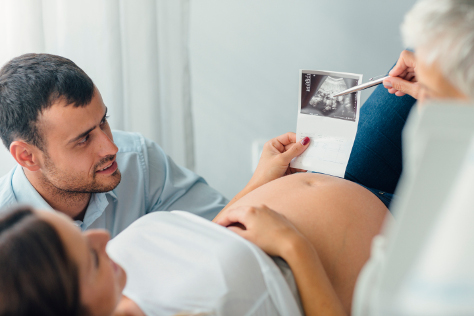What you need to know about your third trimester growth scan
If you are offered a growth scan in your third trimester, here's what you need to know

You’ve had your 12 week dating scan and your 20 week pregnancy anomaly scan so why might you need a third trimester pregnancy growth scan? As the name suggests, this scan is to check how well your baby is growing! This ultrasound scan is usually performed at around 36 weeks of pregnancy.
Why do I need to have a growth scan?
Your doctor or midwife might suggest a third-trimester pregnancy growth scan to ensure that your baby is developing as expected. Some hospitals may offer a growth scan as routine for certain pregnancies such as a raised Body Mass Index (BMI), or if there are concerns that the baby is smaller or larger than expected based on measuring your bump.
The scan will show your sonographer:
-
If your baby is smaller than expected
-
If your baby is larger than expected
-
The position of you baby in the womb
-
If the amniotic fluid volume around your baby is within normal ranges
-
If the blood flow between your baby and placenta is within normal ranges
-
The position of your baby
If there are other issues such as reduced fetal movements, women would be offered a scan in the third trimester. This would usually involves assessment of the growth, liquor and dopplers - to help show if the baby is getting all the oxygen and nutrients they need via the placenta.
What will the scan tell me?
If your baby is smaller than expected (Small for Gestational Age). This means your baby is smaller than usual for your number of weeks pregnant. Your baby might be small all over, or of standard size but lower in weight. Your doctor will closely monitor your baby’s development and might recommend further Doppler ultrasound scans; this measures the blood flow around your baby’s body and identifies if it is lower than normal growth. If it is, it could be due to restricted oxygen supply or a lack of necessary nutrition to the fetus through the placenta.
If you baby is larger than expected. This means your baby is larger than usual for your number of weeks pregnant. A larger than average baby is usually not a medical concern. If your baby is significantly larger than expected your doctor might want to test you for gestational diabetes to check if there is too much glucose (sugar) in your blood. This could lead to complications giving birth and increases the likelihood of needing induced labour or a caesarean section.
The scan reveals the position of your baby in the womb which usually stabilises from around 36 weeks into your pregnancy. Your sonographer will be able to see whether your baby is in the normal position (head down), breech position (feet first) or lying sideways (transverse position). If your baby is in the breech position your doctor might advise that you have an ECV (External Cephalic Version) which is a safe, but sometimes uncomfortable procedure where a physician or surgeon pushes down on and around your abdomen in order to turn your baby into the normal head down position for birth. If ECV doesn’t work, your doctor will discuss your options of having a caesarian birth or talk you through vaginal birth in the breech position.